Numerical Results on Slip Effect over an Exponentially Stretching/Shrinking Cylinder
Abstract
:1. Introduction
2. Mathematical Modeling
3. Steady-State Case
4. Stability Analysis
5. Results and Discussion
6. Conclusions
- The increment of slip and curvature parameters lead to expansion in the range of the solutions.
- The skin friction coefficient decreased whereas the heat transfer coefficient increased as slip parameter increased.
- The increment of the curvature parameter caused the skin friction and heat transfer coefficient to increase.
- Cu has the highest skin friction coefficient and heat transfer coefficient.
- The larger nanoparticle volume fraction is required to increase the skin friction and heat transfer coefficient.
- The first solution is stated as a stable solution and is physically realizable, whereas the second solution is not.
7. Future Directions
- Constructing the mathematical model in different type of fluid such as hybrid nanofluid, micropolar fluid, etc.
- Constructing the mathematical model in an unsteady case when time variable is taken into consideration.
- Adding some other effects such as MHD, thermal radiation and viscous dissipation.
Author Contributions
Funding
Institutional Review Board Statement
Informed Consent Statement
Data Availability Statement
Acknowledgments
Conflicts of Interest
Nomenclature
| Roman Letters | |||
| constant | Radius of cylinder | ||
| Alumina | Reynolds number | ||
| Stretching/shrinking constant | Local Reynolds number | ||
| Skin friction coefficient | Time | ||
| Specific heat at constant temperature | Constant fluid temperature | ||
| Copper | Fluid temperature of the ambient fluid | ||
| Heat capacitance of the nanofluid | Constant temperature rate | ||
| Thermal conductivity | Titania | ||
| Thermal conductivity of the nanofluid | axes | ||
| Characteristics length | Free stream velocity | ||
| Nusselt number | Stretching/shrinking velocity | ||
| Pr | Prandtl number | Slip velocity at the boundary | |
| Heat flux from the surface of the plate | Cartesian coordinate | ||
| Greek Symbols | |||
| Effective thermal diffusivity of the nanofluid | Dimensionless curvature parameter | ||
| Similarity variable | Dimensionless slip parameter | ||
| Stream function | Dimensionless time variable | ||
| Nanoparticle volume fraction | Skin friction or the shear stresses | ||
| Dimensionless temperature | Effective thermal conductivity of the nanofluid | ||
| Stretching/shrinking parameter | Dynamic viscosity of the nanofluid | ||
| Critical point of stretching/shrinking parameter | Kinematic viscosity coefficient | ||
| Eigenvalue parameter | Density of the nanofluid | ||
References
- Oztop, H.F.; Abu-Nada, E. Numerical study of natural convection in partially heated rectangular enclosures filled with nanofluids. Int. J. Heat Fluid Flow 2008, 29, 1326–1336. [Google Scholar] [CrossRef]
- Sulochana, C.; Sandeep, N. Stagnation point flow and heat transfer behavior of Cu–water nanofluid towards horizontal and exponentially stretching/shrinking cylinders. Appl. Nanosci. 2016, 6, 451–459. [Google Scholar] [CrossRef] [Green Version]
- Aleng, N.L.; Bachok, N.; Arifin, N.M. Boundary layer flow of a nanofluid and heat transfer over an exponentially shrinking sheet: Copper-Water. Math Comp. Meth. Sci Tech. 2014, 21, 137–142. [Google Scholar]
- Bhattacharyya, K. Boundary layer flow and heat transfer over an exponentially shrinking sheet. Chin. Phys. Lett. 2011, 28, 074701. [Google Scholar] [CrossRef]
- Najib, N.; Bachok, N.; Arifin, N.M.; Ishak, A. Boundary layer stagnation point flow and heat transfer past a permeable exponentially shrinking cylinder. Int. J. Math. Models Meth. Appl. Sci. 2014, 8, 121–126. [Google Scholar]
- Chaudhary, S.; Singh, S.; Chaudhary, S. Thermal radation effects on MHD boundary layer flow over an exponentially stretching surface. Appl. Math. 2015, 6, 295–303. [Google Scholar] [CrossRef] [Green Version]
- Rao, J.A.; Vasumathi, G.; Mounica, J. Joule heating and thermal radiation effects on MHD boundary layer flow of a nanofluid over an exponentially stretching sheet in a porous medium. World J. Mech. 2015, 5, 151–164. [Google Scholar] [CrossRef]
- Khan, J.A.; Mustafa, M.; Hayat, T.; Sheikholesiami, M.; Alsaedi, A. Three-dimensional flow of nanofluid induced by an exponentially stretching sheet: An application to solar energy. PLoS ONE 2015, 10, 18. [Google Scholar] [CrossRef]
- Shankaralingappa, B.M.; Madhukesh, J.K.; Sarris, I.E.; Gireesha, B.J.; Prasannakumara, B.C. Influence of Thermophoretic Particle Deposition on the 3D Flow of Sodium Alginate-Based Casson Nanofluid over a Stretching Sheet. Micromachines 2021, 12, 1474. [Google Scholar] [CrossRef]
- Punith Gowda, R.J.; Naveen Kumar, R.; Jyothi, A.M.; Prasannakumara, B.C.; Sarris, I.E. Impact of Binary Chemical Reaction and Activation Energy on Heat and Mass Transfer of Marangoni Driven Boundary Layer Flow of a Non-Newtonian Nanofluid. Processes 2021, 9, 702. [Google Scholar] [CrossRef]
- Yusuf, T.A.; Mabood, F.; Prasannakumara, B.C.; Sarris, I.E. Magneto-Bioconvection Flow of Williamson Nanofluid over an Inclined Plate with Gyrotactic Microorganisms and Entropy Generation. Fluids 2021, 6, 109. [Google Scholar] [CrossRef]
- Benos, L.T.; Sarris, I.E. The interfacial nanolayer role on magnetohydrodynamic natural convection of an Al2O3-water nanofluid. Heat Transf. Eng. 2021, 42, 89–105. [Google Scholar]
- Benos, L.T.; Karvelas, E.G.; Sarris, I.E. Crucial effect of aggregations in CNT-water nanofluid magnetohydrodynamic natural convection. Therm. Sci. Eng. Prog. 2019, 11, 263–271. [Google Scholar] [CrossRef]
- Waini, I.; Ishak, A.; Pop, I. Mixed convection flow over an exponentially stretching/shrinking vertical surface in hybrid nanofluid. Alex. Eng. J. 2020, 59, 1881–1891. [Google Scholar] [CrossRef]
- Arshad, M.; Hussain, A.; Hassan, A.; Haider, Q.; Ibrahim, A.H.; Alqurashi, M.S.; Almaliki, A.H.; Abdussattar, A. Thermophoresis and Brownian Effect for Chemically Reacting Magneto-Hydrodynamic Nanofluid Flow across an Exponentially Stretching Sheet. Energies 2022, 15, 143. [Google Scholar] [CrossRef]
- Dero, S.; Rohni, M.A.; Saaban, A. MHD micropolar nanofluid over an exponentially stretching/shrinking surface: Triple solution. J. Adv. Res. Fluid Mech. Therm. Sci. 2019, 56, 165–174. [Google Scholar]
- Mat, N.A.A.; Arifin, N.M.; Nazar, R.; Bachok, N. Boundary layer stagnation point slip flow and heat transfer towards a shrinking/stretching cylinder over a permeable surface. Appl. Math. 2015, 6, 466–475. [Google Scholar] [CrossRef] [Green Version]
- Bachok, N.; Najib, N.; Arifin, N.M.; Senu, N. Stability of dual solutions in boundary layer flow and heat transfer on a moving plate in a copper-water nanofluid with slip effect. WSEAS Trans. Fluid Mech. 2016, 11, 151–158. [Google Scholar]
- Wahid, N.S.; Arifin, N.M.; Khashi’ie, N.S.; Pop, I. Hybrid Nanofluid Slip Flow over an Exponentially Stretching/Shrinking Permeable Sheet with Heat Generation. Mathematics 2021, 9, 30. [Google Scholar] [CrossRef]
- Khan, M.; Rasheed, A. Slip velocity and temperature jump effects on molybdenum disulfide MoS2 and silicon oxide SiO2 hybrid nanofluid near irregular 3D surface. Alex. Eng. J. 2021, 60, 1689–1701. [Google Scholar] [CrossRef]
- Hussain, A.; Arshad, M.; Hassan, A.; Rehman, A.; Ahmad, H.; Baili, J.; Gia, T.N. Heat transport investigation of engine oil based rotating nanomaterial liquid flow in the existence of partial slip effect. Case Stud. Therm. Eng. 2021, 28, 101500. [Google Scholar] [CrossRef]
- Merkin, J.H. On dual solutions occurring in mixed convection in a porous medium. J. Eng. Math. 1985, 20, 171–179. [Google Scholar] [CrossRef]
- Ismail, N.S.; Arifin, N.M.; Bachok, N.; Mahiddin, N. Stagnation-point flow and heat transfer over an exponentially shrinking sheet: A stability analysis. AIP Conf. Proc. 2016, 1739, 20023. [Google Scholar]
- Najib, N.; Bachok, N.; Arifin, N.M. Stability of dual solutions in boundary layer flow and heat transfer over an exponentially shrinking cylinder. Indian J. Sci. Technol. 2016, 9, 6. [Google Scholar] [CrossRef] [Green Version]
- Najib, N.; Bachok, N.; Arifin, N.M.; Senu, N. Boundary layer flow and heat transfer of nanofluids over a moving plate with partial slip and thermal convective boundary condition: Stability analysis. Int. J. Mech. 2017, 11, 19–24. [Google Scholar]
- Merkin, J.H.; Najib, N.; Bachok, N.; Ishak, A.; Pop, I. Stagnation-point flow and heat transfer over an exponentially stretching/shrinking cylinder. J. Taiwan Inst. Chem. Eng. 2017, 74, 65–72. [Google Scholar] [CrossRef]
- Tiwari, R.J.; Das, M.K. Heat transfer augmentation in a two-sided lid-driven differentially heated square cavity utilizing nanofluids. Int. J. Heat Mass Transf. 2007, 50, 2002–2018. [Google Scholar] [CrossRef]
- Harris, S.D.; Ingham, D.B.; Pop, I. Mixed Convection Boundary-Layer Flow Near the Stagnation Point on a Vertical Surface in a Porous Medium: Brinkman Model with Slip. Transp. Porous Media 2009, 77, 267–285. [Google Scholar] [CrossRef]
- Dzulkifli, N.F.; Bachok, N.; Pop, I.; Yacob, N.A.; Arifin, N.M.; Rosali, H. Unsteady stagnation-point flow and heat transfer over an exponential stretching sheet in copper-water nanofluid with slip velocity effect. J. Phys. Conf. Ser. 2018, 1132, 12029. [Google Scholar] [CrossRef]
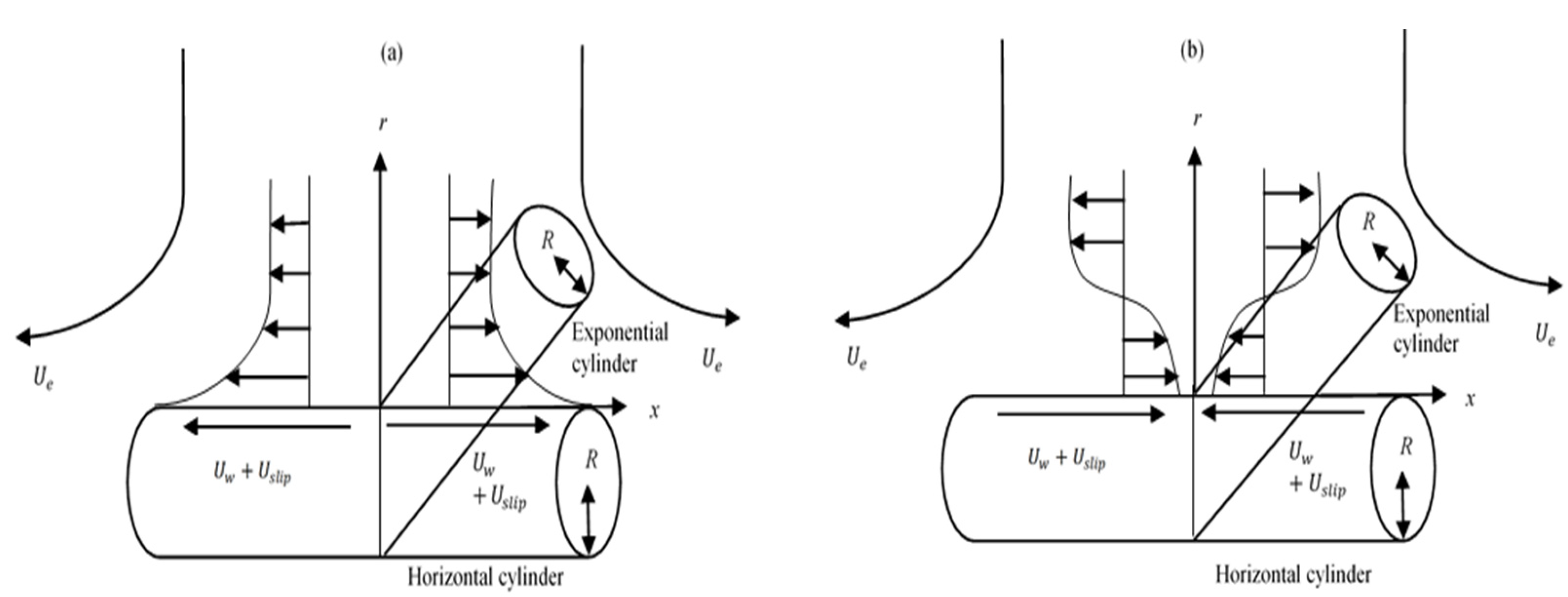
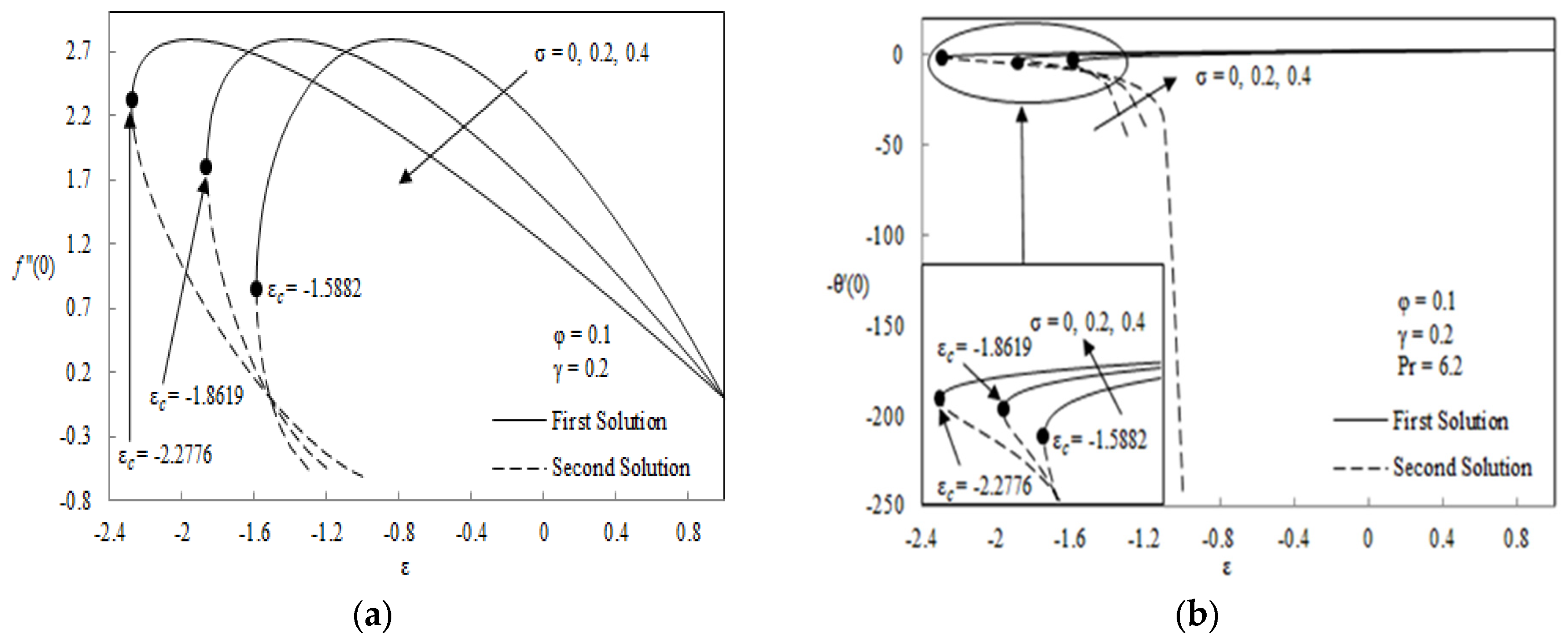
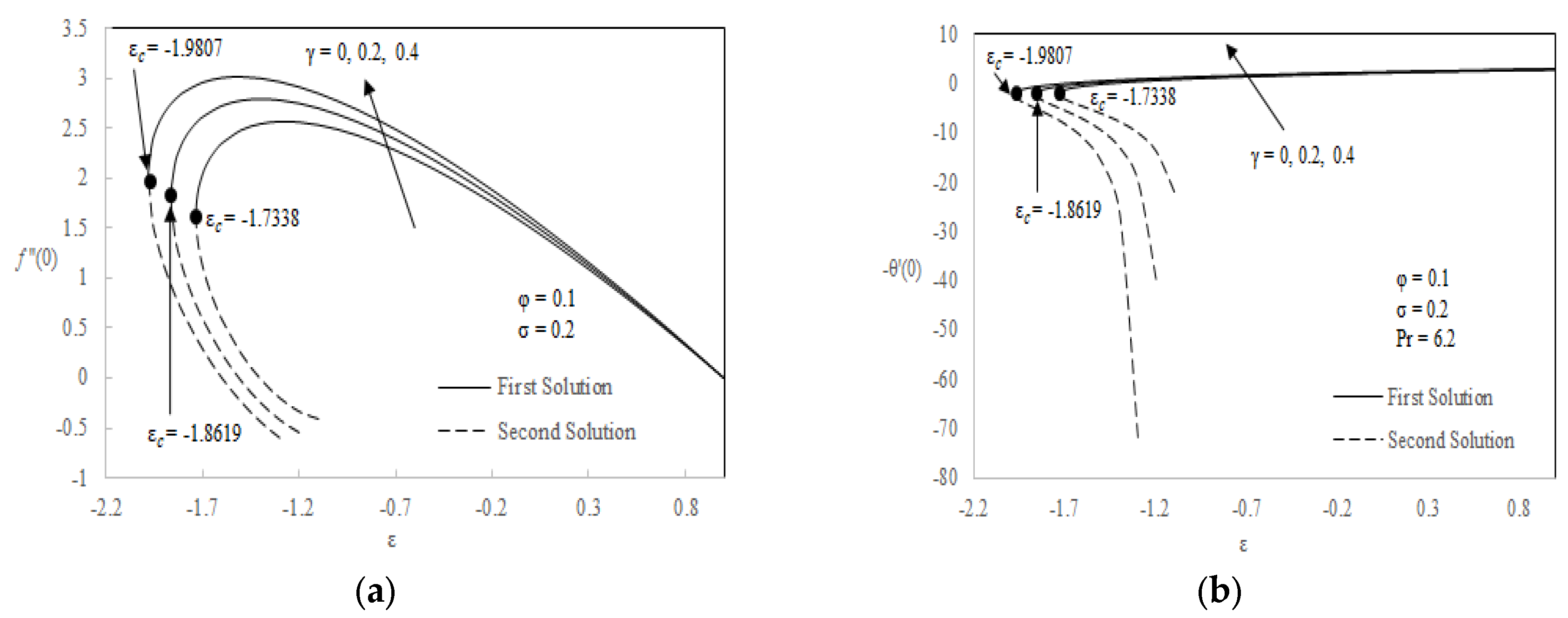
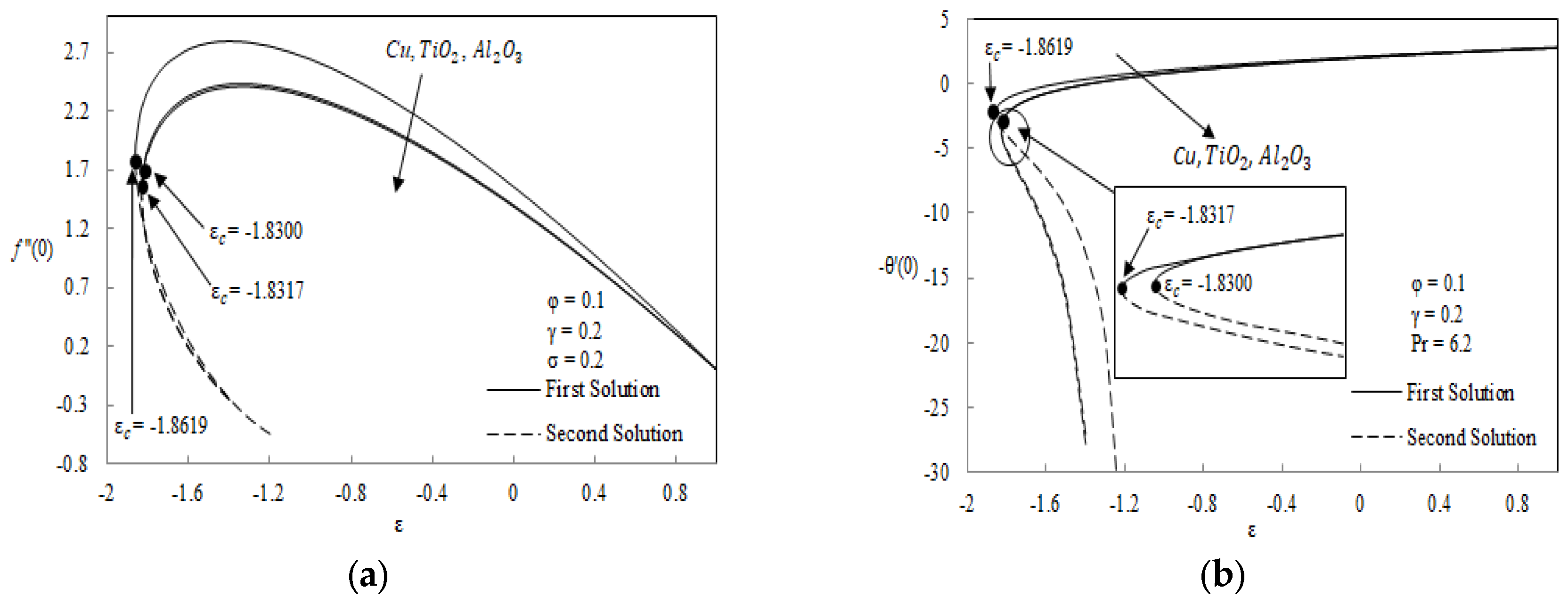
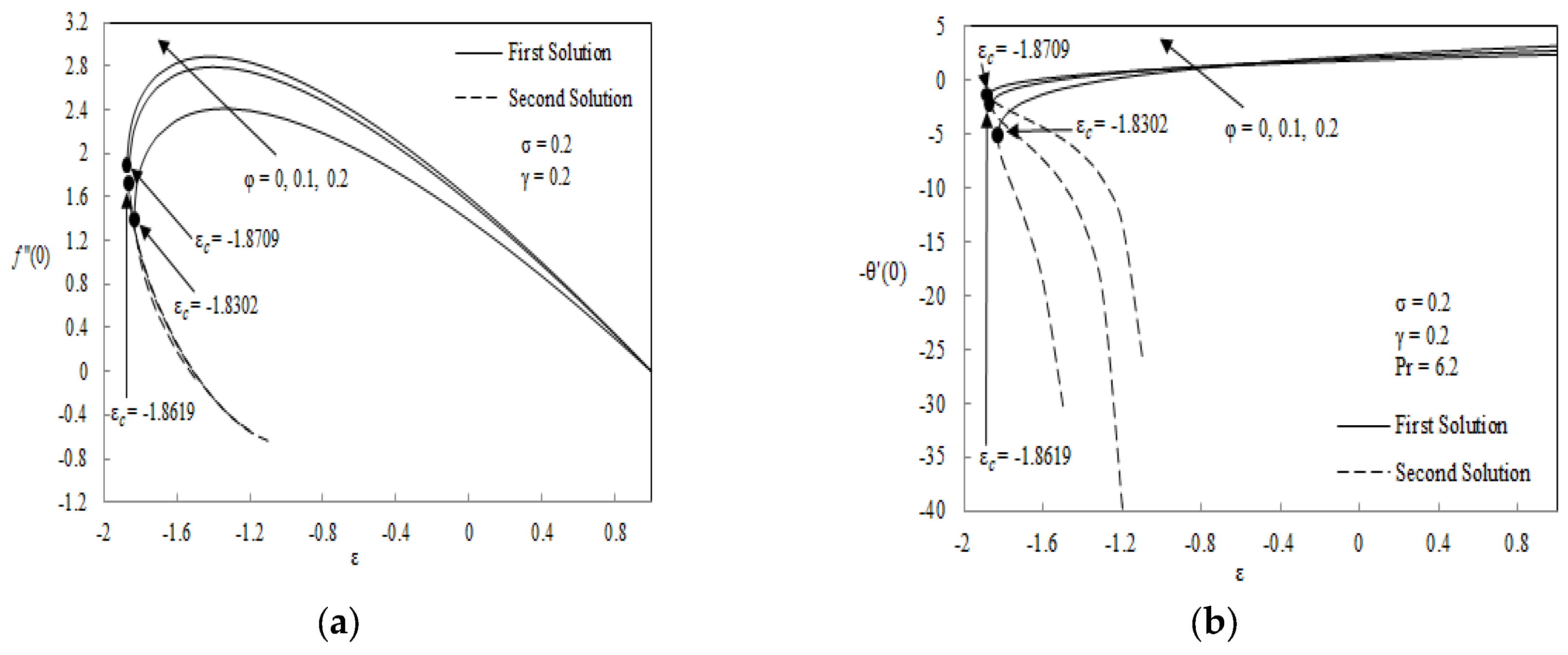
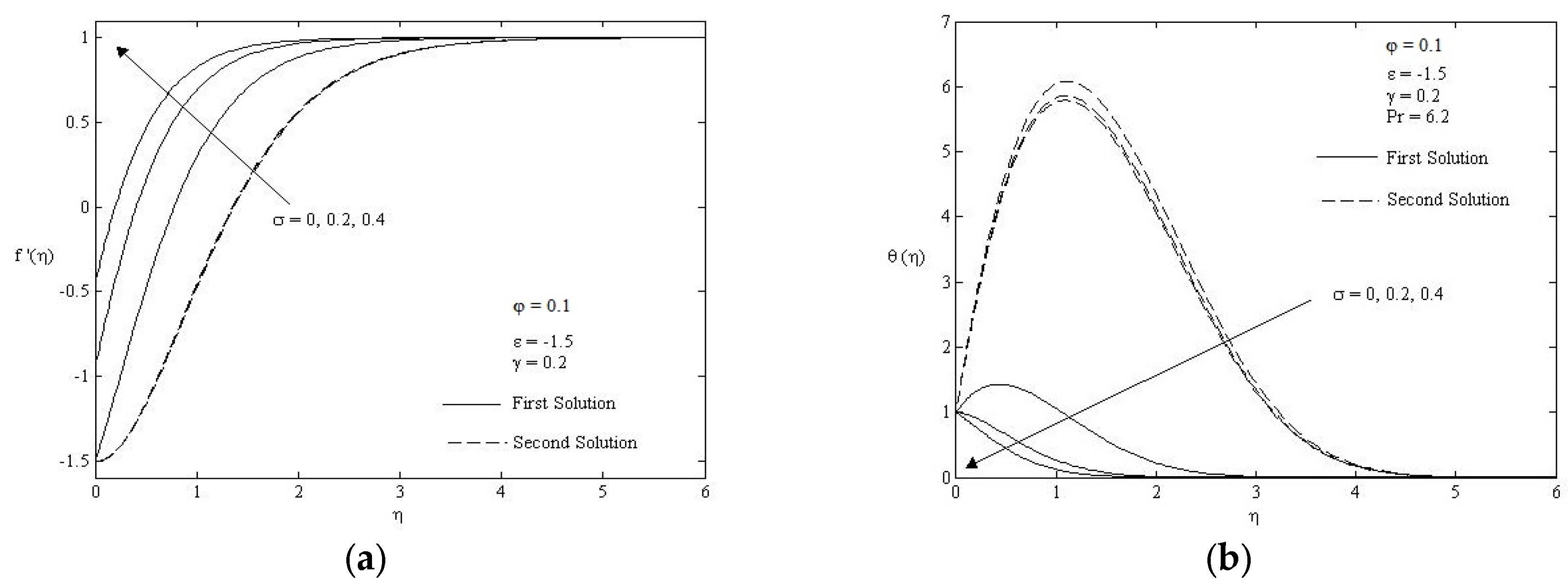

| Dzulkifli et al. [29] | Present Study | |||
|---|---|---|---|---|
| −0.5 | 2.118168665 | 0.687002248 | 2.118168666 | 0.687002250 |
| 0 | 1.687218164 | 1.714771539 | 1.687218164 | 1.714771538 |
| 0.5 | 0.960416075 | 2.487418731 | 0.960416075 | 2.487418731 |
| First Solution | Second Solution | ||
|---|---|---|---|
| 0 | −1.588 | 0.0705 | −0.0704 |
| −1.58 | 0.4512 | −0.4480 | |
| −1.5 | 1.4727 | −1.4378 | |
| −1.4 | 2.1286 | −2.0519 | |
| 0.2 | −1.861 | 0.1407 | −0.1404 |
| −1.86 | 0.1995 | −0.1990 | |
| −1.8 | 1.1129 | −1.0957 | |
| −1.7 | 1.7872 | −1.7409 | |
| 0.4 | −2.277 | 0.0992 | −0.0991 |
| −2.27 | 0.3449 | −0.3438 | |
| −2.2 | 1.0980 | −1.0865 | |
| −2.1 | 1.6528 | −1.6255 |
Publisher’s Note: MDPI stays neutral with regard to jurisdictional claims in published maps and institutional affiliations. |
© 2022 by the authors. Licensee MDPI, Basel, Switzerland. This article is an open access article distributed under the terms and conditions of the Creative Commons Attribution (CC BY) license (https://creativecommons.org/licenses/by/4.0/).
Share and Cite
Najib, N.; Bachok, N.; Dzulkifli, N.F.; Pop, I. Numerical Results on Slip Effect over an Exponentially Stretching/Shrinking Cylinder. Mathematics 2022, 10, 1114. https://doi.org/10.3390/math10071114
Najib N, Bachok N, Dzulkifli NF, Pop I. Numerical Results on Slip Effect over an Exponentially Stretching/Shrinking Cylinder. Mathematics. 2022; 10(7):1114. https://doi.org/10.3390/math10071114
Chicago/Turabian StyleNajib, Najwa, Norfifah Bachok, Nor Fadhilah Dzulkifli, and Ioan Pop. 2022. "Numerical Results on Slip Effect over an Exponentially Stretching/Shrinking Cylinder" Mathematics 10, no. 7: 1114. https://doi.org/10.3390/math10071114
APA StyleNajib, N., Bachok, N., Dzulkifli, N. F., & Pop, I. (2022). Numerical Results on Slip Effect over an Exponentially Stretching/Shrinking Cylinder. Mathematics, 10(7), 1114. https://doi.org/10.3390/math10071114







